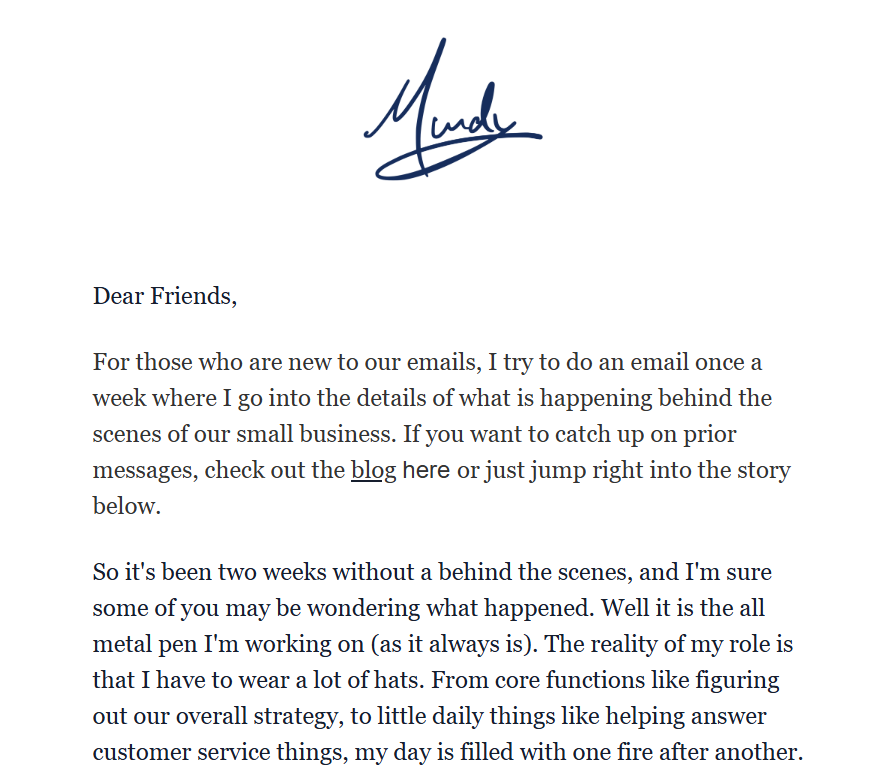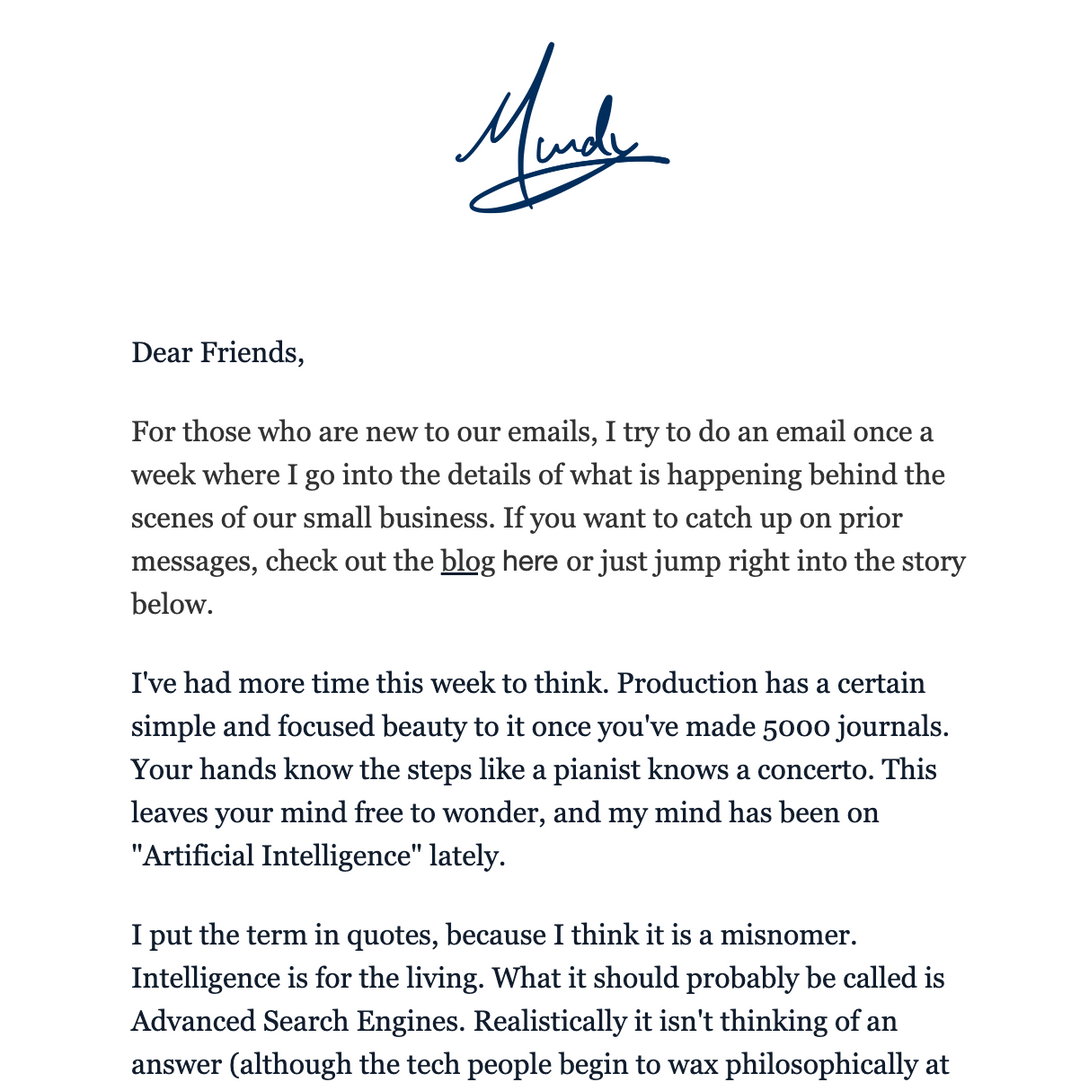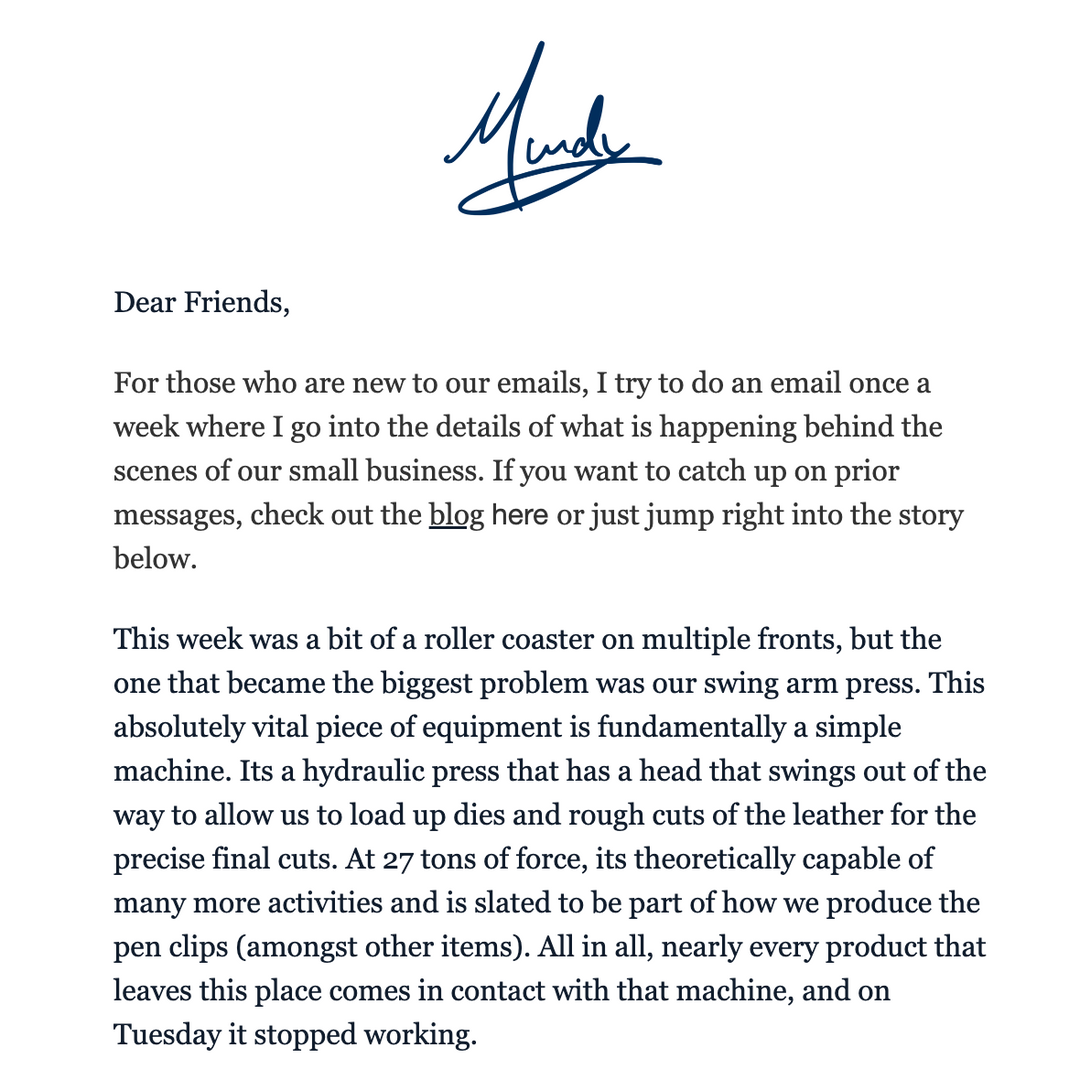Behind the Scenes - 1/24/2025

Dear Friends,
For those who are new to our emails, I try to do an email once a week where I go into the details of what is happening behind the scenes of our small business. If you want to catch up on prior messages, check out the blog here or just jump right into the story below.
I don't know about you, but it seems the noise in the world today is just dreadful. The irony of me sending out an email, which some would say just adds to the noise, about the noise is not lost on me but bear with me here.
The social media platform TikTok has been going through a bit of whiplash about whether it will be banned or not in the US. Now this hasn't affected me or the company directly as we haven't used the platform for a few years. I left it due to my concern that it was spyware (which I think is still true even if the new owners are American) and that I was directly supporting the platform with my attention. I've also avoided spending money on ads on the platform, although I'm not convinced our domestic corporate overlords are much better. In 2018 when Google removed the "Don't be Evil" clause from their code of conduct it certainly raised some red flags for me.
Due to my dislike for TikTok, it has meant that we have intentionally narrowed our reach. We have mainly been relegated to spending money on Meta (Facebook and Instagram) and Alphabet (Youtube and Google). These platforms have been the most reliable way for us to get in front of new customers. After several years and a rather serious amount of ad spend on Meta, I've begun to develop some conspiracy theories about the platform that has caused me to shift more of our ad spend towards Google over the last few months.
For years we have tried everything under the sun to scale up our Meta Ads. Every type of creative, campaign structure, and budget seems to yield results that support my theory. I think that Meta has decided who our customers are, and no matter what we spend the pool stays the same.
This is actually a broader theory that I have written about in my journal many times.
I think that with the vast data Meta has collected about individuals over the years they have a very complex analysis of their users. They know who are the people who look at ads but never click on them. They know who the "browsers" are that just click on ads and look around, but aren't really likely to spend money. Finally they know who the real value people are. They are the ones who will look at an ad, click on it, and buy from the company.
If you were in their shoes, how would you best monetize this reality? Well to start they offer various "goals" that you can set for your campaigns. Do you want impressions (that's cheap views on your ads), or do you want traffic? Finally they have "sales" as a goal. For a long time the conventional marketing thinking was to build your ad campaigns around a funnel. Part of your budget was spent on impressions, part was spent on link clicks, and part was spent on conversions.
The logic was simple. You get a ton of people to see your ads for cheap, some of them will be interested. They see another ad and decide to click, maybe browse around, and then a few days later they see another ad and buy.
Here's where my conspiracy lies.
I think they know that the people they are selling as "impressions" are never going to buy. The people that see our campaigns to click, may click, but they aren't going to buy. Which only leaves the "sales" target campaign as the one that generates sales. Those people do follow the process outlined above, but not because of the structure, but because Meta always thought they would be a good fit.
Technically, they aren't lying when they sell you this. In fact they are giving you exactly what you pay for. It's just the funnel as a concept that isn't true. The likely pool of customers on the platform that are really the most interested in buying your product at any given time is a nearly fixed group, and I think Meta knows this and knows who they are. This leads to the second part of what I've seen in my years doing this.
If I spend $400 a day, or $1200 per day, the number of people that see my ads are nearly the same, they just charge me three times as much.
Now there are some caveats to this. If I spend $40 per day, I will only have one tenth of the pool see my ads. So essentially there is a somewhat linear relationship between my ad spend and my impressions up until I max out the pool. Then the cost rises quickly with very little gain. Also the ad quality matters, that's a given, and too small of a budget will limit the algorithms ability to properly "learn" who of the pool to serve the ad too for maximum effectiveness.
So the real lesson that I've learned is there is a ceiling on the ad spend on Meta at which point, I might as well light the money on fire. At least then it would keep me warm for a little while.
This fact is what has been pushing me to diversify some of our ad spend onto Google. The reality there is precisely the same, for all the same reasons. However we haven't really fully covered all the advertising areas on that platform yet to find the ceiling. During the last two weeks I've essentially proven where the ceiling is on one type of our Google ads, and now I'm working on starting a new search marketing campaign on Google. Hopefully due to the different part of the ecosystem it will show up within, we can get some additional sales from it at the same cost as the other areas.
This gets to the heart of a deeper question. How do we get people's attention in a noisy world?
We are a small business with a very real limit to what our ad spend can generate in sales on the few platforms we are spending money on. New platforms like Pinterest for example, have had dismal returns to the point of just not being an option really. So where do we go from here.
The first step has been to carefully limit our size to fit within the bounds of the sales that our marketing can generate. That's a pretty new development and so far it's working.
We have had some success with single content creators like ParkNotes on Youtube, which is good but rare, and very difficult to replicate. I would love to have more retail partners. Our product would be a good fit for some of them, but finding them and getting them onboard is a real challenge, and very time consuming.
So I've been working on a new idea, expanding our product line to hopefully bring more people into our social media pools. This is what the pen launch is partly aimed at. There are people who are not journal people, but certainly are pen people. Right now we have nothing to offer them, but if we can get the pen finished, then our pool can expand to include them, and maybe they will become journal people through us. We have another project in the early stages that has a similar idea to bring on a whole new audience with new product types.
I would love to hear your thoughts on my theory, and any ideas you have for how we can do a better job getting people's attention. Are there places online that you spend your time that you feel we would be a good fit and access more customers? I am open to suggestions, and appreciate your thoughts.
That's what has been going here this week. Pen development, and working through the complex data
Stay tuned for more letters on Fridays in the coming weeks and be sure to go subscribe to our YouTube channel. If you like and watch the videos it helps us get promoted more by the algorithm to people who may never have heard of us.
Ever your servant,
Colin Murdy CEO/Owner
Murdy Creative Co.
Cell: 414-434-9001
MurdyCreative.Co
Binders | Journals | Folios | Sleeves | Folders | Briefcases | Covers | Accessories






